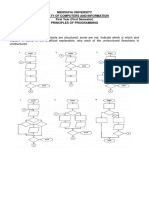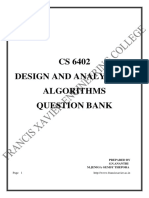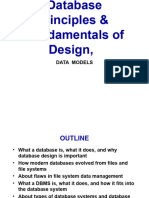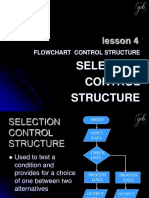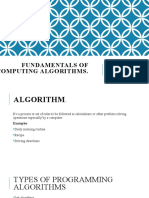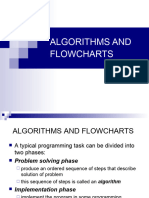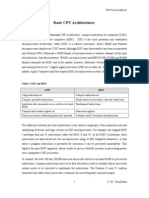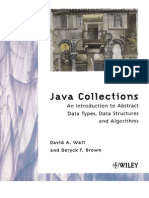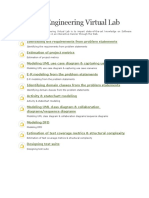0 ratings0% found this document useful (0 votes)
2K viewsProgramming Logic and Design
This document provides details about an introductory computer programming logic course including the course name, description, units, contact hours, prerequisites, outcomes, outline, laboratory experiments, and equipment. The course teaches programming logic concepts like data types, control structures, arrays, and debugging techniques.
Uploaded by
prince_kc2002Copyright
© © All Rights Reserved
Available Formats
Download as DOCX, PDF, TXT or read online on Scribd
0 ratings0% found this document useful (0 votes)
2K viewsProgramming Logic and Design
This document provides details about an introductory computer programming logic course including the course name, description, units, contact hours, prerequisites, outcomes, outline, laboratory experiments, and equipment. The course teaches programming logic concepts like data types, control structures, arrays, and debugging techniques.
Uploaded by
prince_kc2002Copyright
© © All Rights Reserved
Available Formats
Download as DOCX, PDF, TXT or read online on Scribd
You are on page 1/ 1
Course Name Programming Logic and Design
Course This is an Introductory course in computer programming logic. The
Description student will learn algorithms applicable to all programming languages,
including: identifiers, data types, arrays, control structures, modular
programming, generating reports, and computer memory concepts. The
student will learn to use charts commonly used in business and
information processing. Program logic will be developed using flowcharts
and pseudo code. Programs will be written using any programming
Language.
Number of Units 2 units
for Lecture
Number of 6 hours per week
Contact Hour
per Week
Prerequisites None
Program c-I
Outcomes
Course After completing this course, the student must be able to:
Outcomes 1. Identify important steps in program development cycle
2. Draw a flowchart to represent the program’s logic
3. Break down programming problems into modules
Course Outline 1. Introduction to Computers and Logic
2. Tools for Developing Program Logic: Flowchart and Pseudocode
instructions
3. Logical Control Structures : Sequence ,Selection/Decision, Iteration
/Loop, Case
4. Data and Data Types, Constants and Variables, Operators and Its
Hierarchy
5. Looping: While Loop, Do... While Loop, For Loop
6. Lists and Arrays: Representation ,Arrays Interpolation, Add and Delete,
Operators and Functions , Slicing
7. Debugging Techniques: Steps /Process in Debugging, Approaches,
Debugging tools
Laboratory Laboratory exercises to be identified by the program.
Experiments Each major topic should have a corresponding laboratory exercise.
For semestral program, 15 exercises per semester.
For trimestral program, 12 exercises per trimester.
For quarterm program, 9 exercises per quarter.
Laboratory Computer and object-oriented programming software tool
Equipment Depending on the class size
1 computer per student
You might also like
- Programming Logic and Design Comprehensive 6th Edition Joyce Farrell download pdf100% (8)Programming Logic and Design Comprehensive 6th Edition Joyce Farrell download pdf81 pages
- Programming Logic and Design, 9th Edition. Chapter 10% (3)Programming Logic and Design, 9th Edition. Chapter 119 pages
- CS114 - Fundamentals of Programming: Qurrat-Ul-Ain Babar100% (1)CS114 - Fundamentals of Programming: Qurrat-Ul-Ain Babar80 pages
- Menoufia University Faculty of Computers and Information First Year (First Semester) Principles of ProgrammingNo ratings yetMenoufia University Faculty of Computers and Information First Year (First Semester) Principles of Programming7 pages
- Logic Formulation and Introduction To ProgrammingNo ratings yetLogic Formulation and Introduction To Programming18 pages
- Systems Architectures: System Integration & ArchitectureNo ratings yetSystems Architectures: System Integration & Architecture34 pages
- COEN 3134 - Logic Circuits and Switching Theory Syllabus - CANSINONo ratings yetCOEN 3134 - Logic Circuits and Switching Theory Syllabus - CANSINO4 pages
- Fundamentals of Database System Prelim Quiz 1No ratings yetFundamentals of Database System Prelim Quiz 115 pages
- 104 - Programming and Problem Solving Through 'C LanguageNo ratings yet104 - Programming and Problem Solving Through 'C Language3 pages
- Sir Syed University of Engineering & Technology, Karachi: CS-128T Digital Logic DesignNo ratings yetSir Syed University of Engineering & Technology, Karachi: CS-128T Digital Logic Design34 pages
- Course-Outline - Object Oriented ProgrammingNo ratings yetCourse-Outline - Object Oriented Programming3 pages
- All Basic Principles and Concept of DatabasesNo ratings yetAll Basic Principles and Concept of Databases83 pages
- TM01 Apply Object-Oriented Programming Language SkillsNo ratings yetTM01 Apply Object-Oriented Programming Language Skills102 pages
- Iptchapter5 151207213412 Lva1 App6891 PDFNo ratings yetIptchapter5 151207213412 Lva1 App6891 PDF17 pages
- ITEC54 - System Integration and Architecture - IntroductionNo ratings yetITEC54 - System Integration and Architecture - Introduction6 pages
- Chapter 3-Database Systems Eighth Edition PresentationNo ratings yetChapter 3-Database Systems Eighth Edition Presentation55 pages
- Algorithms Made Simple: Understanding the Building Blocks of SoftwareFrom EverandAlgorithms Made Simple: Understanding the Building Blocks of SoftwareNo ratings yet
- COD-COE Instrument As of April 23, 2015 FinalNo ratings yetCOD-COE Instrument As of April 23, 2015 Final9 pages
- Computer Networks and Security LaboratoryNo ratings yetComputer Networks and Security Laboratory1 page
- Bibliography: You Are Suggested To Go Through Them For Further DetailsNo ratings yetBibliography: You Are Suggested To Go Through Them For Further Details1 page
- Computer Engineering Drafting and DesignNo ratings yetComputer Engineering Drafting and Design1 page















